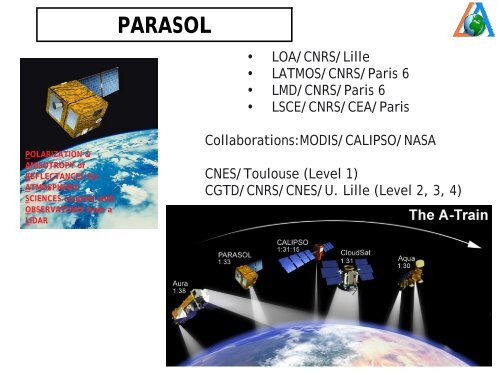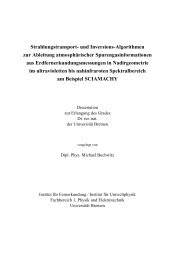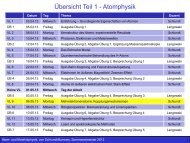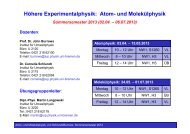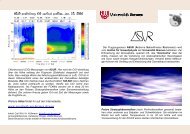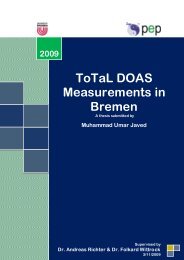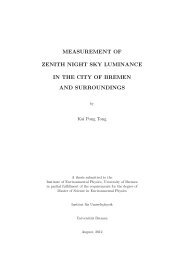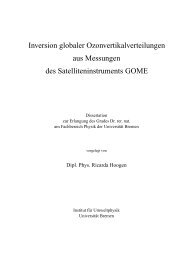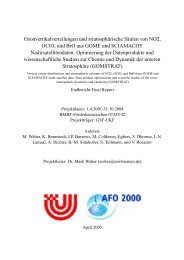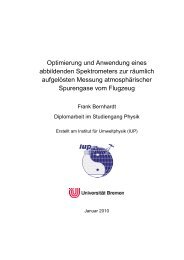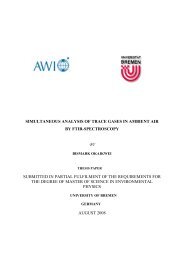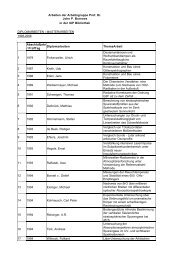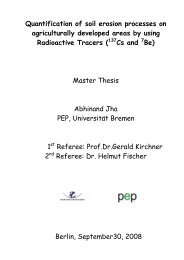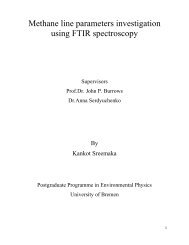AEROSOL over CLOUD - IUP
AEROSOL over CLOUD - IUP
AEROSOL over CLOUD - IUP
You also want an ePaper? Increase the reach of your titles
YUMPU automatically turns print PDFs into web optimized ePapers that Google loves.
POLARIZATION &<br />
ANISOTROPY of<br />
REFLECTANCES for<br />
ATMOSPHERIC<br />
SCIENCES coupled with<br />
OBSERVATIONS from a<br />
LIDAR<br />
PARASOL<br />
• LOA/CNRS/Lille<br />
• LATMOS/CNRS/Paris 6<br />
• LMD/CNRS/Paris 6<br />
• LSCE/CNRS/CEA/Paris<br />
Collaborations:MODIS/CALIPSO/NASA<br />
CNES/Toulouse (Level 1)<br />
CGTD/CNRS/CNES/U. Lille (Level 2, 3, 4)
Directional<br />
Measurements<br />
QuickTime et un<br />
décompresseur H.264<br />
sont requis pour visionner cette image.<br />
Wide FOV CCD Camera with 1600 km swath width<br />
•+/- 43 degrees cross track - +/- 51degrees along track<br />
Spectral<br />
Measurements<br />
9 spectral bands: 443-1020nm<br />
3 are polarized (490, 670, 865 nm)<br />
• Spatial resolution : 6.2 km x 5.3 km<br />
• No onboard calibration system - Inflight vicarious calibration :<br />
–2-3% absolute calibration accuracy<br />
–1% spectral calibration accuracy<br />
–1% polarization calibration accuracy
Over Ocean,the POLDER instrument carries enough<br />
informations to discriminate between three different<br />
modes of particles:<br />
• fine mode (pollution or biomass burning),<br />
• spherical coarse mode (maritime),<br />
• non-spherical coarse mode (dust) (when<br />
geometrical conditions are suitable).<br />
Over land, the POLDER instrument uses the polarized<br />
radiances for getting:<br />
• fine mode (pollution or biomass burning),<br />
• the corresponding angström exponent.
One single NS model = Volten et al.<br />
R = ρ 670 /ρ 865 ; DLm = quality of the fit.<br />
The fraction of AOD due to major natural and anthropogenic<br />
components : fine mode, and a coarse mode with a combination of<br />
hydrated spherical particles and of non spherical particles (dust).<br />
Upper: Total radiances<br />
Lower: Polarized radiances<br />
Dots: measurements<br />
Lines: retrieval<br />
Herman et al., 2004
Why polarization is useful for aerosol remote sensing <strong>over</strong> land:<br />
L<br />
sol<br />
p<br />
• is low compared to atmospheric contribution<br />
• is spectrally independent<br />
• is more uniform<br />
• can be roughly estimated from surface classification<br />
Maximum variation of the surface<br />
polarization from Beijing to<br />
Xianghe ~ 2.0×10 -3 at 110°-120° After atmospheric corrections from AERONET<br />
Fan et al., 2007<br />
Deuzé et al., 2001
Clear atmosphere (AOT=0.03) : reflectance<br />
at TOA is close to the surface values<br />
Clear atmosphere (AOT=0.08) : the reflectance<br />
at TOA is again close to the surface values<br />
<strong>AEROSOL</strong><br />
Hazy atmosphere : large aerosol contribution,<br />
1.0×10 -2 at 110°-120° for AOT=0.31<br />
Hazy atmosphere : aerosol contribution < 10 -3 for<br />
AOT =0.7<br />
Illustration for<br />
Biomass Burning<br />
Aerosols<br />
Limitation for some<br />
aerosol types:<br />
Illustration for<br />
Desert Aerosols<br />
Deuzé et al., 2001
LEVEL 3<br />
Total Fine Mode<br />
Non-Spherical Coarse: « Dust » Spherical Coarse: « maritime »<br />
PARASOL Optical thicknesses <strong>over</strong> Ocean Sept 2005
Years<br />
2005/6<br />
2006/7<br />
2007/8<br />
2008/9<br />
season<br />
AOD (accumulation mode)<br />
MAM JJA SON DJF
Benefits from Polarization:<br />
•Determination of the refractive index (real part),<br />
•The absorption (in the blue) and the altitude<br />
•Aerosols above a cloud deck<br />
New scheme that can work <strong>over</strong> land
Refractive index of the aerosols<br />
within the accumulation mode<br />
Spectral effect<br />
for the size<br />
determination,<br />
here:<br />
R = L 670/L 865<br />
Spectral ratio<br />
2,2<br />
2<br />
1,8<br />
1,6<br />
1,4<br />
1,2<br />
R 133<br />
R 145<br />
R 160<br />
P 133<br />
P 145<br />
P 160<br />
0,8<br />
0,6<br />
0,4<br />
0,2<br />
1<br />
-0,2<br />
0,02 0,04 0,06 0,08 0,1 0,12 0,14 0,16 0,18<br />
Mean radius<br />
1<br />
0<br />
Polarization ratio<br />
around 110° at 670nm<br />
Refractive Index<br />
Polarization ratio<br />
Log-normal size distributions<br />
reff=0.07-0.13-0.17-0.22μm<br />
m=1.35-1.45-1.60
Refractive index of the large spherical mode:<br />
radiances<br />
Polarized<br />
radiances<br />
Based on the location of the rainbow<br />
observed in polarized light<br />
Polarized phase function q( Θ)<br />
0,2<br />
0,1<br />
-0,1<br />
-0,2<br />
0<br />
Coarse mode<br />
Spherical particles<br />
rmoy=0.75 μm-sigma=0.70<br />
λ=865 nm<br />
q 0.75mu 1.33<br />
q 0.75mu 1.37<br />
q 0.75mu 1.40<br />
q 0.75mu 1.45<br />
q 0.75mu 1.50<br />
80 100 120 140 160 180<br />
Scattering angle Θ<br />
(145°/155°) the refractive index<br />
is estimated to be 1.35±0.02<br />
Exact Reff value is not crucial
490nm<br />
POLARIZED RADIANCE<br />
0,0360<br />
0,0340<br />
0,0320<br />
0,0300<br />
0,0280<br />
0,0260<br />
0,0240<br />
0,0220<br />
0,0200<br />
ω 0 = 0.860, 0.880, 0.902, 0.925, 0.947, 0.974<br />
reff = 0.2µm<br />
Molecular<br />
Absorption<br />
Scattering angle: 102°<br />
0,02 0,04 0,06 0,08 0,10 0,12 0,14<br />
no surface<br />
Z=0.5km<br />
Z=1.5km<br />
Z=2.5km<br />
Z=3.5km<br />
Z=4.5km<br />
Z=5.5km<br />
Z=6.5km<br />
Z=7.5km<br />
Z=8.5km<br />
Z=9.5km<br />
Z=10.5km<br />
AOD(490nm)=0.5<br />
m'=0.020<br />
m'=0.015<br />
m'=0.025<br />
m'=0.010<br />
m'=0.030<br />
m'=0.005<br />
RADIANCE<br />
Z=1.5km<br />
AOD(490nm)=1.0<br />
Z=3.5km<br />
Z=5.5km<br />
Aerosol Properties<br />
are extrapolated in<br />
the blue<br />
Z km<br />
4.0<br />
3.0<br />
Altitude:<br />
<strong>over</strong> land<br />
and ocean<br />
3.5
June 2006 - December 2008<br />
Comparison with CALIOP <strong>over</strong> land
QuickTime et un<br />
décompresseur TIFF (non compressé)<br />
sont requis pour visionner cette image.<br />
<strong>AEROSOL</strong> <strong>over</strong> <strong>CLOUD</strong><br />
*LIDAR Alt from 5km Cloud Layer product<br />
Case study: Aug. 18 2006<br />
CALIOP<br />
PARASOL<br />
MODIS
865nm<br />
Detection (and quantification) of aerosol layers above cloud<br />
Waquet et al., 2009<br />
Inversion: Lidar/Parasol/Modis<br />
AOT<br />
Lidar PATH
f j * - PARASOL data:<br />
Angular measurements (~15 angles) of<br />
- Intensity (λ = 0.49; 0.67; 0.87; 1.02 μm)<br />
- Polarization (λ = 0.49; 0.67; 0.87 μm)<br />
A Priori Constraints limiting derivatives (e.g. Dubovik 2004) of<br />
- for aerosols (e.g. in AERONET, Dubovik and King 2000) :<br />
- aerosol size distribution variability <strong>over</strong> size range;<br />
- spectral variability of complex refractive index;<br />
- for surface (e.g. in AERONET/satellite retrievals, Sinuyk et al. 2007) :<br />
- spectral variability of BRF/ PBRF parameters.<br />
New inversion scheme<br />
Both bi-directional intensity and polarization reflectance and aerosols are retrieved simultaneously<br />
Single - Pixel Retrieval:<br />
QuickTime et un<br />
décompresseur TIFF (LZW)<br />
sont requis pour visionner cette image.<br />
*<br />
f j<br />
∗<br />
0j = F ⎧<br />
⎪ ⎛<br />
j<br />
⎨ ⎜<br />
⎩ ⎪ ⎝<br />
a j - Parameters to be retrieved:<br />
-Aerosol propetries:<br />
- size distribution; - real refractive index- altitude<br />
- imaginary refractive index; - particle shape<br />
-Surface properties (<strong>over</strong> land):<br />
- BRF parameters; -BPRF parameters<br />
D j<br />
⎞<br />
⎟<br />
⎠<br />
a j +<br />
Δ j m<br />
a<br />
Δ j<br />
Multi-term LSM Multi-Pixel Solution:<br />
Multi-Pixel a priori constraints (e.g.Dubovik et al. 2008):<br />
- limited spatial variability of each aerosol /surface parameter<br />
- limited temporal variability of each aerosol /surface<br />
parameter<br />
NOTE: degree of variability constraints (smoothnes) can be<br />
different and adequately chosen for each parameter<br />
Dubovik et al., 2009
B<br />
QuickTime and a<br />
TIFF (Uncompressed) decompressor<br />
are needed to see this picture.<br />
Retrieved parameters:<br />
Refractive index (réel): 1.53-1.55<br />
Non-spherical fraction: 97%<br />
Aerosol layer altitude (width 1.5 km): 0.4 km (Jan 1); 0.5 km (Jan 3)<br />
0.7 km (Jan 5); 1.2km (Jan 6)<br />
Aerosol Optical Thickness<br />
Preliminary results from PARASOL <strong>over</strong> a bright surface ( Banizoumbou, Niger)<br />
PARASOL: 4 PIXELS<br />
North 13 0 30 ’’, East 2 0 36 ’’; North 13 0 30 ’’, East 2 0 43 ’’<br />
North 13 0 36 ’’, East 2 0 36 ’’. North 13 0 36 ’’, East 2 0 43 ’’<br />
5<br />
4<br />
3<br />
2<br />
1<br />
Aerosol Optical Thickness <strong>over</strong> BANIZOUMBOU<br />
(January 1-6, 2007)<br />
0.44 AERONET<br />
0.67 AERONET<br />
0.87 AERONET<br />
1.02 AERONET<br />
0.44 PARASOL<br />
0.67 PARASOL<br />
0.87 PARASOL<br />
1.02 PARASOL<br />
0<br />
1 2 3 4 5 6 7<br />
Days: 1- 6 of January, 2007<br />
Single Scattering Albedo<br />
1<br />
0.95<br />
0.9<br />
0.85<br />
Absorption of Aerosol <strong>over</strong> BANIZOUMBU<br />
(January 1-6, 2007)<br />
0.8<br />
Jan 1, AERONET<br />
Jan 3, AERONET<br />
Jan 5, AERONET<br />
Jan 6, AERONET<br />
0.75<br />
Jan 1, PARASOL<br />
Jan 3, PARASOL<br />
Jan 5, PARASOL<br />
0.7<br />
Jan 6, PARASOL<br />
0.4 0.5 0.6 0.7 0.8 0.9 1 1.1<br />
Wavelengths, μm<br />
Surface Albedo<br />
0.7<br />
0.6<br />
0.5<br />
0.4<br />
0.3<br />
0.2<br />
0.1<br />
January 3, 2007<br />
January 6, 2007<br />
Surface albedo <strong>over</strong> BANIZOUMBU<br />
(January 1-6, 2007)<br />
MODIS<br />
PARASOL<br />
0<br />
0 0.5 1 1.5 2 2.5<br />
Wavelengths, μm
PARASOL data are available: New instrument<br />
Level 1 data :http://parasol-polder.cnes.fr/<br />
PARASOL aerosol and cloud products are available on line at<br />
http://www.icare.univ-lille1.fr/<br />
PARASOL is slowly leaving the A-Train<br />
New instrument: Extension to MIR channels (1.6 and<br />
2.1µm) and to UV (0.36µm)
The debate : How good (or<br />
bad) are the present aerosol<br />
products <strong>over</strong> ocean?
AOD P =a x AOD M + b (0.25°x0.25° resolution; 52 months)
Red dots: AERONET oceanic sites<br />
4206 Coincident measurements: 03/2005-06/2008
Backup slides
AOT of PARASOL/POLDER-2<br />
AOT of PARASOL<br />
VALIDATION: land<br />
AOT of AERONET Fine Mode (r≤0.3µm)<br />
Ångström Exponent of PARASOL<br />
Ångström Exponent of PARASOL<br />
Ångström Exponent of AERONET Fine Mode<br />
AOT of AERONET Fine Mode (r≤0.3µm) Ångström Exponent of AERONET Fine Mode
Total AOT 670 nm<br />
Fine Mode AOT 550nm<br />
GSFC [Anthropogenic] Hamburg<br />
Parasol MODIS<br />
MODIS give very good results for total AOT.<br />
Parasol and MODIS fine mode AOT are excellent<br />
Parasol MODIS<br />
Bréon et al. 2009/GEOMON<br />
AOD COMPARISON BETWEEN MODIS or PARASOL with AERONET
Fine Mode AOT 550nm<br />
Total AOT 670 nm<br />
Mongu [Biomass Burning]<br />
Parasol MODIS<br />
Bréon et al. 2009/GEOMON<br />
MODIS gives<br />
good results<br />
for total AOT.<br />
Parasol fine<br />
mode AOT is<br />
excellent -<br />
MODIS is not<br />
as good<br />
AOD COMPARISON BETWEEN MODIS or PARASOL with AERONET
<strong>AEROSOL</strong> <strong>over</strong> <strong>CLOUD</strong> - Detection<br />
Difference in Cloud Top Pressure retrieval from O2 and Rayleigh Scattering.<br />
04 2005 08 2005


